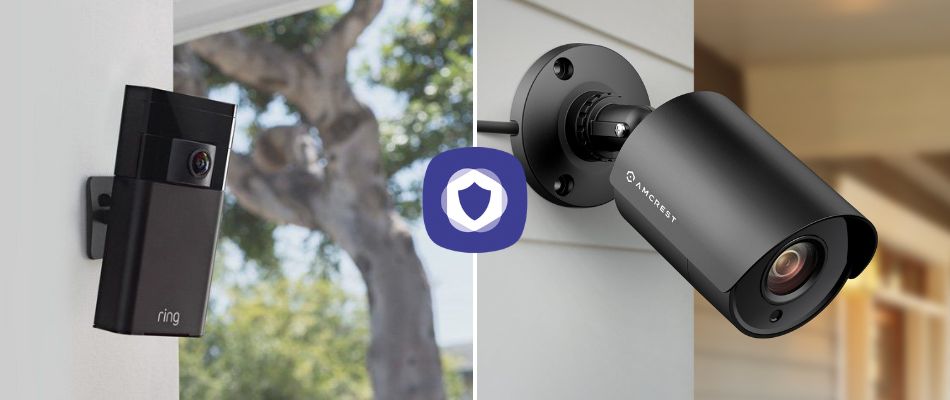If you've decided to purchase new security cameras, you'll have a few decisions. There is a range of cameras and equipment available in the industry, from video doorbells to outdoor cameras with night vision.
Ring and Amcrest cameras offer high-quality home security cameras, but some key differences exist. Ring is an Amazon-owned company that shot to fame for the Ring video doorbell. Amcrest is known for offering a range of products from baby monitors to GPS trackers. Let's look at what they offer.
Ring vs Amcrest: What do they have in common?
- Alexa integration: The cameras can be integrated with Amazon's Alexa.
- Hardware: Many of the cameras provided by Ring and Amcrest are 2.4ghz Wi-FI-operated cameras with wired power sources.
- Night vision: You can opt for a camera with night vision.
- Motion detection: Motion-activated camera recording is a feature shared.
- Mobile app: You'll have access to a high-quality mobile app that allows easy management of your security system; you can also receive notifications and use two-way audio from the app.
- Camera quality: Both cameras feature 1080p HD video quality as standard, though some 4k options exist.
- Person detection: You can rely on the high-tech person detection camera feature.
- Cloud storage: Cloud storage is available with Ring and Amcrest; you'll rely less on local storage options.
Ring vs Amcrest: What are the differences?
- Monthly fees: Ring seems to add on extras, and your services will be more limited without a cloud subscription. Amcrest charges additional fees if you want to record continuously or with motion detection.
- Safety equipment: Ring is compatible with extra safety equipment, such as smoke alarms and carbon monoxide detectors.
- Local storage: More Amcrest systems rely on MicroSD cards and other forms of local storage.
- Professional monitoring: Amcrest doesn't offer professional monitoring; you need to be comfortable with a fully DIY system.
- Complex setup: Despite being a DIY system, Amcrest's cameras can be more complicated, though the Wi-Fi cameras aren't too difficult.
- Solar power: More of Ring's equipment relies on solar-powered backups, such as the bullet camera, whereas Amcrest products use a typical battery-powered backup.
Amcrest: What you need to know
Amcrest is a relatively new provider that offers a variety of cameras, from plug-in Wi-Fi cameras to smart doorbells and ethernet/wired systems. Amcrest offers NVR systems and can provide large multi-camera packages.
Installation
Since Amcrest offers various cameras, the installation process varies. A Wi-Fi camera is as simple as it gets. Some equipment is plug and play, but some cameras, such as the PoE Amcrest, would need a more complex setup, including drilling; you may want a professional on-side to ensure it works correctly. DVR and NVR systems are the most complex.
If a user-friendly installation is important to you, choose a Wi-Fi camera.
Home automation
Our SecurityNerd was advised that Alexa is the only current third-party automation. Amcrest could stand to improve here, with only one single integration on offer. Aside from that, customers can choose dedicated smart products such as video doorbells.
Pricing
Amcrest provides several types of UltraHD security cameras, from motorized outdoor cameras to bullet options, drones, and baby monitors.
The range of products means it's hard to provide accurate pricing, but it can vary from $50+ for a Wi-Fi camera to $3000+ for a comprehensive NVR system. Most domestic users spend around $200-$300 on their system.
Nerd Pros
- Customization: You can customize your camera system to your requirements; with some cameras, you can edit frame rate, sensitivity, motion zones, etc., from within the app.
- No subscriptions: Monthly subscriptions are optional unless you choose an upgraded cloud storage plan; there are no monthly fees.
Nerd Cons
- Limited integration: Amcrest doesn't provide the best home system for a smart home ecosystem; the only meaningful integration is Alexa. There is a limited selection of smart home products, but there are no extras like thermostats or smart plugs.
- More complex install: Some products will require a tricky install which isn't ideal for a DIY provider. You may want to stick to a Wi-Fi camera.
- No professional monitoring: You need to be comfortable self-monitoring as, despite motion sensors and push notification alerts, there is no third-party monitoring. Though our SecurityNerd was advised that some security companies will integrate with Amcrest cameras, you won't find a dedicated monitoring service.
Ring: What you need to know
Ring entered the home security industry with a bang in 2013, offering a revolutionary video doorbell camera that several other companies have tried to emulate since. While Ring began as a humble doorbell company, it now offers much more, including traditional security cameras.
Installation
While the battery-powered cameras are easy to install, the wired ones can be difficult and require hardwiring/drilling into your existing electrical system. Installation can be costly, as you may be forced to consult a professional. Amazon.com may offer you an independent estimate for this.
Home automation
Ring can be easily incorporated into a smart home security system, including smoke detectors, lighting, window sensors, and other Ring-compatible features. Third-party integrations are few, but Ring has an exclusive range, including smart locks, lights, outlets, garage door sensors, and alarm sirens.
Pricing
- Equipment costs: For an alarm system, you can expect to pay $179 for a basic five-piece kit, though more expensive kits are available. Individual cameras start at $99.
- Monthly costs: Monthly costs are optional, but you can purchase monitoring for $10 a month. You can get a discount by paying yearly ($100).
Pros
- Indoor and outdoor cameras: Ring offers cameras suitable for indoor and outdoor use; most come with night vision, motion sensors, and other unique perks.
- Affordability: You can get a 5-piece set from Ring for just $179; you can add on extras such as paid storage plans or professional monitoring; they're also affordable but optional.
- Professional monitoring option: If you're looking for extra peace of mind, you can get 24/7 professional monitoring at a fraction of the usual price, costing just $10 a month.
Cons
- Limited package options: Most of Ring's packages are set in stone; they're not very customizable.
- Video storage fees: If you want to store any of your videos, you must sign up for a storage plan. Some companies don't charge this.
- Upfront payment: You'll have to pay more upfront as you can't spread the cost with a payment plan.
Ring or Amcrest?
Ring and Amcrest offer excellent cameras with great specs, but some differences exist. If you're looking for professional monitoring, you should pay particular attention to Ring. Amcrest doesn't offer professional monitoring, only motion alerts/push notifications. Still, if you're looking for an NVR system with multiple cameras, Amcrest is ideal. Ring is great if you're looking for a cheap system with only 1-3 cameras.
This article has been reviewed and approved by Officer Banta.

Officer Banta is the official SecurityNerd home security and safety expert. A member of the Biloxi Police Department for over 24 years, Officer Banta reviews all articles before lending his stamp of approval. Click here for more information on Officer Banta and the rest of our team.

